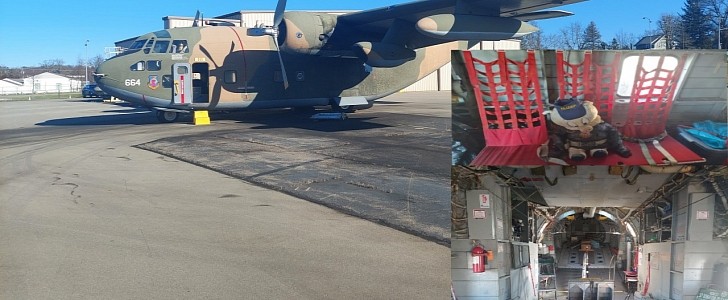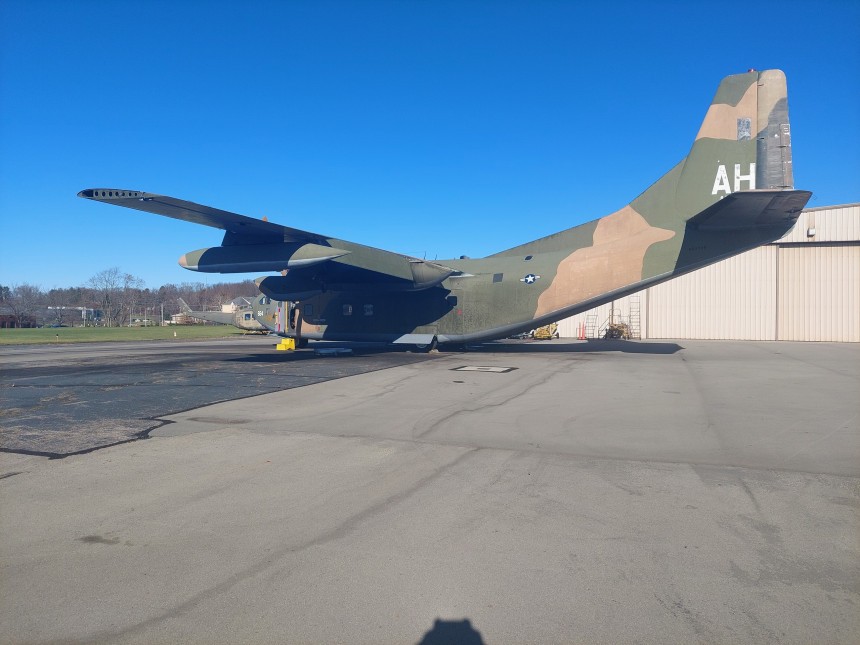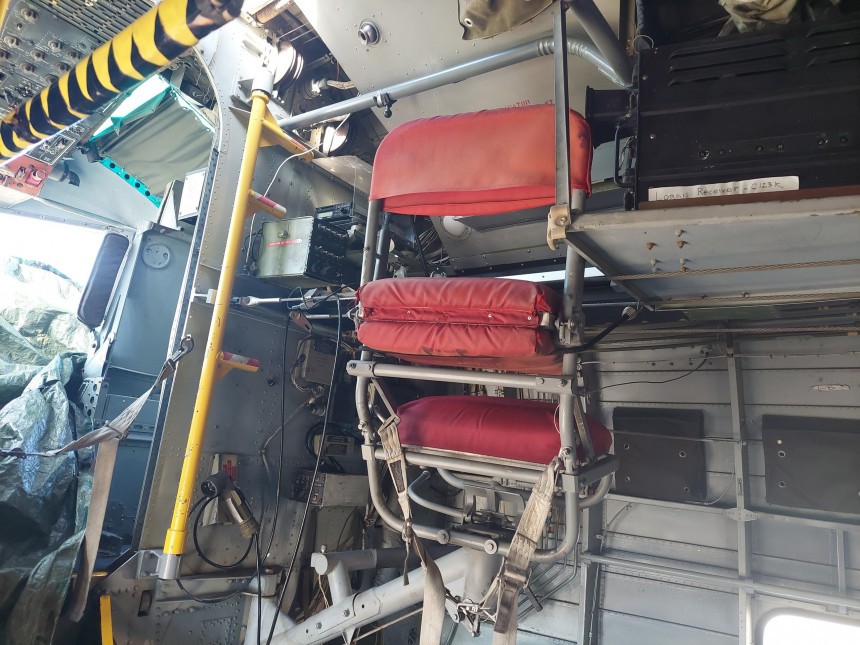The internet is full of hyperbole. So when we come across something claimed to be the last of its kind in the world, forgive us for being skeptical. We've done the research, and we've crunched the numbers, so when we tell you this is the very last airworthy Fairchild C-123-K Provider left on planet earth, it's the real deal.
Nicknamed "Thunderpig," this final flyable Cold War cargo plane has a fascinating history, especially for something so mundane. If you can believe this 34 foot tall, 75-foot long (10.3 and 21m) 36,000-pound (16,329 kg) monster was designed as a glider, then you'd have more foresight than most. Hands across our hearts, scout's honor, the C-123 was legitimately conceived as one of the world's largest unpowered aircraft under the Chase Aviation Company.
History teaches us that such a ludicrous idea isn't so stupid after all. Assault and cargo gliders were used to significant effect during the Second World War. Most famously during the decisive D-Day invasion in June 1944. American forces feared a mainland invasion of the Soviet Union might be imminent in the infant days of the Cold War. A large glider capable of carrying dozens, if not hundreds of soldiers, may very well have been as effective as it was during D-Day.
There was just one catastrophic problem that notion. Simply, that there wasn't a plane powerful enough to haul the brute of a glider at full payload weight. No Lancaster, B-17, B-24, or even the mighty B-29 Superfortress could manage that feat. With that effort turning out to be pointless, it was decided to fit some engines. Not just any engines, mind you, but one of the most famous designs in history.
The Pratt & Whitney R-2800 Double Wasp was perhaps World War Two's most famous radial engine. Its use on the Republic P-47 Thunderbolt, Grumman F6F Hellcat, and Vought F4-U Corsair fighters earned it immortality as a durable and powerful unit. In truth, the Double Wasp was also suited for roles other than in fighters. It turned out to be a remarkably efficient cargo hauler as well.
Fairchild purchased the licence to build the now twin-engined hauler and moved production to Hagerstown, Maryland. The type would serve with the U.S. Air Force and several others in the Far East and South America from then on. The final airworthy example of the Provider resides on the site of the Air Heritage Museum in Beaver Falls, Pennsylvania, about an hour north of Pittsburgh.
We've gone in-depth about some of the other cool stuff on show in this little one hangar museum. Still, the star attraction is Thunderpig, the nickname lovingly given thanks to Fairchild's association with Republic Aviation, makers of the P-47 Thunderbolt, F-105 Thunderchief, and the Fairchild-Republic A-10 Thunderbolt II. Thunderpig rolled out of the factory gates on the fourth of May 1956. From there, it served in support and transportation roles at U.S. airbases across the country and even a trip abroad to England.
Thunderpig was stricken from Air Force reserves and donated to Air Heritage in 1985, and it's been the main attraction ever since. Amazingly, the K variant of the Fairchild Provider experimented with mounting a jet engine underneath each wing. It's said the aircraft could take off over 500 feet (152.4m) with even larger than standard payloads with twin General Electric J85 turbofan engines in tow.
Such engines are complicated and expensive to fuel and maintain, but the nacelles they once sat inside are still present today. Museum staff, who maintain and fly Thunderpig to airshows across the country, tell us it has no problem at all flying with just its twin Double Wasps. Would that make it a Quadruple Wasp? We suppose it doesn't sound as good.
It's a truly bizarre feeling climbing the steps into the cargo bay of this thing. It's very easy for a warbird this old to feel cramped and claustrophobic. Not in a Provider. There's enough room to fit an entire Starbucks inside. However, the education that comes with the free admission to the museum is worth far more than a $6 latte.
The most incredible seat in the house has to be the communication officer's swiveling chair which swings from a position behind the cockpit to a comms station in the top right corner of the fuselage. Swinging between the two positions for an entire flight must have been one of the U.S. Military's most fun jobs. Thunderpig pays for itself with visits to airshows during the spring and summer seasons. We've already seen the Museum's C-47 Skytrain cold-start. We can't wait to show how Thunderpig roars to life when it takes to the skies again, sometime real soon. Check back for that right here on autoevolution.
History teaches us that such a ludicrous idea isn't so stupid after all. Assault and cargo gliders were used to significant effect during the Second World War. Most famously during the decisive D-Day invasion in June 1944. American forces feared a mainland invasion of the Soviet Union might be imminent in the infant days of the Cold War. A large glider capable of carrying dozens, if not hundreds of soldiers, may very well have been as effective as it was during D-Day.
There was just one catastrophic problem that notion. Simply, that there wasn't a plane powerful enough to haul the brute of a glider at full payload weight. No Lancaster, B-17, B-24, or even the mighty B-29 Superfortress could manage that feat. With that effort turning out to be pointless, it was decided to fit some engines. Not just any engines, mind you, but one of the most famous designs in history.
The Pratt & Whitney R-2800 Double Wasp was perhaps World War Two's most famous radial engine. Its use on the Republic P-47 Thunderbolt, Grumman F6F Hellcat, and Vought F4-U Corsair fighters earned it immortality as a durable and powerful unit. In truth, the Double Wasp was also suited for roles other than in fighters. It turned out to be a remarkably efficient cargo hauler as well.
We've gone in-depth about some of the other cool stuff on show in this little one hangar museum. Still, the star attraction is Thunderpig, the nickname lovingly given thanks to Fairchild's association with Republic Aviation, makers of the P-47 Thunderbolt, F-105 Thunderchief, and the Fairchild-Republic A-10 Thunderbolt II. Thunderpig rolled out of the factory gates on the fourth of May 1956. From there, it served in support and transportation roles at U.S. airbases across the country and even a trip abroad to England.
Thunderpig was stricken from Air Force reserves and donated to Air Heritage in 1985, and it's been the main attraction ever since. Amazingly, the K variant of the Fairchild Provider experimented with mounting a jet engine underneath each wing. It's said the aircraft could take off over 500 feet (152.4m) with even larger than standard payloads with twin General Electric J85 turbofan engines in tow.
Such engines are complicated and expensive to fuel and maintain, but the nacelles they once sat inside are still present today. Museum staff, who maintain and fly Thunderpig to airshows across the country, tell us it has no problem at all flying with just its twin Double Wasps. Would that make it a Quadruple Wasp? We suppose it doesn't sound as good.
The most incredible seat in the house has to be the communication officer's swiveling chair which swings from a position behind the cockpit to a comms station in the top right corner of the fuselage. Swinging between the two positions for an entire flight must have been one of the U.S. Military's most fun jobs. Thunderpig pays for itself with visits to airshows during the spring and summer seasons. We've already seen the Museum's C-47 Skytrain cold-start. We can't wait to show how Thunderpig roars to life when it takes to the skies again, sometime real soon. Check back for that right here on autoevolution.



















